Winter 2009
Cooking Classes
|
WINTER
2009 COOKING CLASSES
Online,
In-Person, or by Telephone
Harper's Point classes - Call
513-489-6400 Settler's Walk classes - Call
937-748-4540
www.cookswaresonline.com
To
view the full schedule and all of the details, visit our website now
and plan some fun this winter! Limited seating -- Plan early,
then Register!
Upcoming
February Classes: (View Feb, Mar, and Apr classes at our
website).
Sat, Feb
21 - Classic French Bread
Workshop with Kathy Lehr
Harper's Point from 10:00am -
1:30pm. $60 - Hands-On!
SECOND
SESSION ADDED:
Harper's
Point from 2:30pm - 6:00pm - Hands-On!
Mon, Feb 23 - Fish Cookery with Jeff
Simmons
Harper's
Point from 6:30 - 9:00pm. $50
Mon, Feb 23 - Meatless Meals & Lenten
Favorites with Eric Boston
Settlers' Walk from 6:30 -
9:00pm. $40
Thu, Feb 26 - Adult Culinary Basics
Series - Class 1 of 3 with Greg Genetti
Harper's Point from 6:00- 9:00pm.
$210 for the 3 class series (Class 2 - Mar 5; Class 3 - Mar 12)
Thu, Feb 26 - Pockets Full of Flavor
with Sean Schmidt
Settlers' Walk from 6:30 -
9:00pm. $40
Upcoming
March Classes: (View Mar and Apr classes at our
website).
Tue, Mar
3 - Carrabba's - Simply
Delicious with Dan Rodabaugh
Harper's Point from 6:30 - 9:00.
$45
Wed, Mar 4 - Pockets Full of Flavor
with Sean Schmidt
Harper's Point from 6:30 -
9:00pm. $40
Wed, Mar 4 - BRAVO! Italian Kitchen
with Curtis Sizemore or Ben Draughn
Settlers' Walk from 6:30 -
9:00pm. $40
Thu, Mar 5 - Adult Culinary Basics
Series - Class 2 of 3 with Greg Genetti
Harper's Point from 6:00 -
9:00pm. $210 for the 3 class series (Class 1 - Feb 26; Class 3 - Mar
12)
Thu, Mar 5 - Sauté Away with Gabe
Gardner
Settlers' Walk
from 6:30 - 9:00pm. $35
3 Ways to Register: On-Line, In Store,
or by Phone
Harper's
Point classes - Call 513-489-6400
Settlers'
Walk classes - Call 937-748-4540 www.cookswaresonline.com
10%
Discount on merchandise purchases on the day you attend
class!
(excluding kitchen
electrics). |
Bean
Basics
|
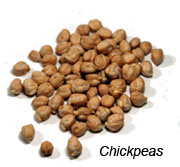 Jack was a Genius!
- We all remember the fable, Jack and the Beanstalk.
Chastised for selling the cow for a few magic beans, Jack redeems
himself by planting the beans, climbing to new heights, and cashing
in on untold treasures. Jack's intuitive sense about beans
versus bovine translates its genius to us today in the form of
everyday beans that provide fantastic nutrition in remarkably
economical ways. Jack was a Genius!
- We all remember the fable, Jack and the Beanstalk.
Chastised for selling the cow for a few magic beans, Jack redeems
himself by planting the beans, climbing to new heights, and cashing
in on untold treasures. Jack's intuitive sense about beans
versus bovine translates its genius to us today in the form of
everyday beans that provide fantastic nutrition in remarkably
economical ways.
What is a
Bean? Beans are part of the legume family of
plants and grow as seeds encased in a protective pod. According to
bean expert, Ken A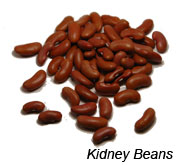 lbala, the author of Bean: A History,
there are over 18,000 different kinds of beans. (If you're a fan of
Lynn Rosetto Kasper's radio program, "The Splendid Table," perhaps
you heard a recent episode where bean expert, Professor Albala was
interviewed. Here's a link to the audio if you're interested
in hearing the interview first hand: Splendid Table - Jan 31,
2009. The interview is about 20 minutes into the podcast).
Beans seem to grow everywhere and not particularly subject to
tightly defined climate conditions. In fact, North Dakota, not
exactly known for its balmy weather or long growing season, is the
largest producer of beans in the U.S. lbala, the author of Bean: A History,
there are over 18,000 different kinds of beans. (If you're a fan of
Lynn Rosetto Kasper's radio program, "The Splendid Table," perhaps
you heard a recent episode where bean expert, Professor Albala was
interviewed. Here's a link to the audio if you're interested
in hearing the interview first hand: Splendid Table - Jan 31,
2009. The interview is about 20 minutes into the podcast).
Beans seem to grow everywhere and not particularly subject to
tightly defined climate conditions. In fact, North Dakota, not
exactly known for its balmy weather or long growing season, is the
largest producer of beans in the U.S.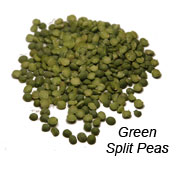
Whopping Nutrition!
- Beans have incredible health benefits; they've gained the
title of "miracle food" precisely because of the economical,
well-rounded nutrition they provide.
- High in
protein - a single 1/2-cup serving of beans provides 7-8
grams of protein, or 10% of the Recommended Daily Allowance (RDA).
- Essentially
fat-free - a single serving has less then 0.5 grams of fat,
and the right kind, unsaturated.
- Good
carbs - beans are full of complex carbohydrates, the type
that moderates insulin levels while providing long-term satiation.
- High fiber
qualities - one serving provides 25-30% of RDA for fiber
rivaling many whole grains. The 75% insoluble and 25%
soluble fiber ratio promotes digestive health and potentially
reduces blood cholesterol.
- Nutrient
rich - one serving contains relatively large amounts of
calcium, iron, potassium, folic acid, and other B
vitamins.
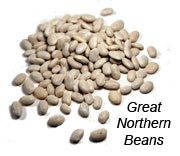 Beans are a perfect solution to reducing high
fat, meat-based menus - something nutritionists are recommending
with increasing urgency! In fact, the 2005 USDA nutritional
guidelines specify that individuals should consume 3 cups of beans
each week. Beans officially qualify for the FDA-approved
health claims stating that "diets including beans may reduce your
risk of heart disease and certain cancers." Further, "studies
also suggest eating beans as a part of a healthy diet may help to
manage diabetes and help cut the risk of high blood pressure and
stroke." Beans are a perfect solution to reducing high
fat, meat-based menus - something nutritionists are recommending
with increasing urgency! In fact, the 2005 USDA nutritional
guidelines specify that individuals should consume 3 cups of beans
each week. Beans officially qualify for the FDA-approved
health claims stating that "diets including beans may reduce your
risk of heart disease and certain cancers." Further, "studies
also suggest eating beans as a part of a healthy diet may help to
manage diabetes and help cut the risk of high blood pressure and
stroke."
Counting Beans- If
the nutritional benefits of beans weren't enough to convince you
about adopting more of them in your diet, the numbers will!

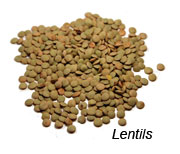 Pair them Up! -
Nutritionally, beans and grains are perfect complements for each
other. Beans are high in protein, especially lysine, a
specific amino acid necessary for building complete protein
structures. But, they are weak in methionine, another
essential amino acid. Conversely, whole grains, also high in
protein, are weak in lysine, but strong in methionine. Pair
the two food groups together in a dish and you have some serious
biofuel to power and build your
body. Pair them Up! -
Nutritionally, beans and grains are perfect complements for each
other. Beans are high in protein, especially lysine, a
specific amino acid necessary for building complete protein
structures. But, they are weak in methionine, another
essential amino acid. Conversely, whole grains, also high in
protein, are weak in lysine, but strong in methionine. Pair
the two food groups together in a dish and you have some serious
biofuel to power and build your
body. |
Bean Cuisine
|
Once looked
down upon as peasant food, or some quirky vegetarian necessity,
beans have gone gourmet in restaurants, and can in your kitchen too!
A perfect culinary canvas, beans soak up spices and flavorings
eagerly. 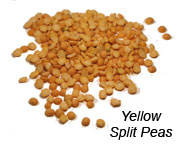 With a rich heritage from around the globe, an
endless variety of time-honored bean preparations are accessible to
all of us. With a rich heritage from around the globe, an
endless variety of time-honored bean preparations are accessible to
all of us.
Don't know beans about cooking
beans? - Starting with dried beans offers the most
nutritional and economic value. And, they taste infinitely
better than their canned counterparts. As a dehydrated food,
beans need to be rehydrated, then cooked to tenderness.
Learning a few key techniques will get you comfortable with using
dried beans and reaping all of their advantages.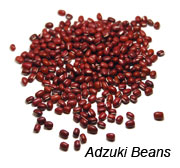
To Soak, or
Not to Soak - Soaking dried beans begins the softening
process and allows the beans to cook more evenly on the
stovetop. (If you use a pressure cooker to cook beans, no
soaking is necessary -- read more on this below!). First,
rinse your dried beans in a colander and look them over to discard
any foreign particles and any discolored or shriveled beans.
Different soaking schemes are available for you to use:
Hot Soaking -
Heat 10 cups of water to boiling, add two cups (1 pound) of dried
beans and boil for 2 to 3 minutes. Remove from the heat
source, cover, and let set for four hours. Hot soaking will
remove up to 50% of the indigestible sugars that beans are sometimes
noted for.
Quick Soaking -
Similar to Hot Soaking, boil 10 cups of water, add two cups of dried
beans, boil for 2 to 3 minutes. Remove from heat, cover, and
let set for one hour.
Overnight
Soaking - Using no heat, place two cups of dried beans in 10
cups of cold water. Allow the beans to set overnight or for at
least 8 hours.
Beans will triple in size as they
rehydrate, so choose a soaking pot that will accommodate this amount
of swelling; use a general ratio of 1 cup dry beans to 5 cups
water.
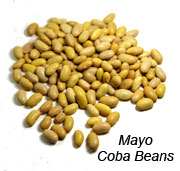
Boiling the
Beans - Drain the soaking water from the beans and
rinse. Add fresh, unsalted water to cover the beans and bring
to a boil over high heat for a few minutes. Reduce the heat to
medium and allow to cook at a full simmer until beans are tender to
the bite. Different beans will vary in the time required for
boiling according to their shape, "thickness," and age. Older
beans will take longer to cook. Beans are done when the
outside skin is still intact, but the bean smashes easily when
squished with a fork.
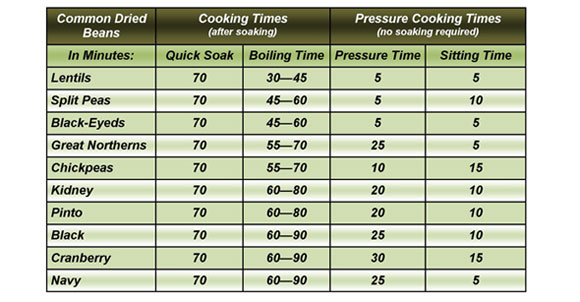
Storing Cooked
Beans - Refrigerate cooked beans in their liquid for up to 5
days. The liquid will help prevent the beans from drying
out. Similarly, bean dishes may be refrigerated for 4-5 days;
the beans will continue to gather the flavor and spices of the dish
and often taste better the second day! Cooked beans may be
frozen for 2 to 3 months and are easily reheated. Boil up a
big batch of beans and package them in convenient sizes for later
use.
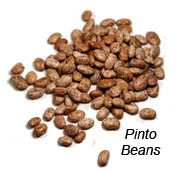 Microwaving Dried
Beans - Generally, experts agree that
microwaving dried beans doesn't work well. They require a
long, low simmering process that is sometimes difficult to achieve
in a microwave setting. Microwaving Dried
Beans - Generally, experts agree that
microwaving dried beans doesn't work well. They require a
long, low simmering process that is sometimes difficult to achieve
in a microwave setting.
Beans in a
Slow Cooker - Experts recommend cooking dried, soaked beans
in a slow cooker on a high setting for 2-3 hours taking care that
they remain immersed in liquid as they swell and absorb the
moisture. After this period, turn the beans to a low setting and
allow them to cook for 6 to 8 hours. This second step requires
less attention. Slow cookers are, of course, great for reheating
cooked beans and preparing all kinds of bean
dishes.
|
Cooking Under Pressure - Healthy in a
Hurry!
|
Cooking beans
in a pressure cooker is modern day magic! It turns them into
"fast food" and allows beans to be part of everyday menus as opposed
to some periodic, heroic effort. Beans are the perfect starter food
for exploring pressure cooking methods. With pressure cooking,
there is no soaking required, and cooking times are, quite
literally, a fraction of the time of saucepan cooking. But
pressure cookers are not just for beans! 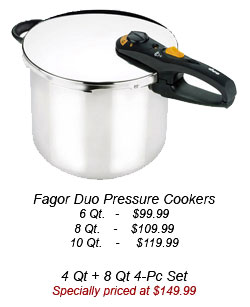 The theory and practice works on all
foods - vegetables, grains, meat, and even desserts. With a little
experience, your pressure cooker will become your most favored
cooking pot in the kitchen! The theory and practice works on all
foods - vegetables, grains, meat, and even desserts. With a little
experience, your pressure cooker will become your most favored
cooking pot in the kitchen!
What is a pressure cooker? - A
pressure cooker is a specialized pot with strong walls, a heavy
bottom, and a specialized lid. The lid fits the pot snugly by
employing a rubber or silicone gasket. The lid locks on the
pot through mechanical means and forms an airtight seal. When heat
is applied to this closed system, pressure builds inside.
Pressure cookers have a primary valve that allows excess steam to
escape when the pressure reaches its set maximum, usually around 15
psi (pounds per square inch). Multiple secondary escape valves
are present should the primary valve fail. Locking mechanisms
keep the steam from escaping unexpectedly or from being opened
prematurely.
How pressure
cooking works - The boiling point of water is 212 degrees
F. No matter how much heat you apply to a pot of water, it
will remain at 212 degrees F. As pressure increases, the boiling
point of water also increases. Under 15 psi of pressure, water
boils at 257 degrees F. This "super-heated" water cooks food
more quickly because of this higher temperature. Also, unlike
an oven where heat is inefficiently transferred through air, with
pressure cooking heat is transferred very efficiently through steam
that is literally forced into the food.
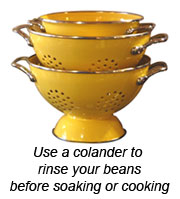 Advantages of
pressure cooking - Pressure cooking offers several advantages
for today's home cook: Advantages of
pressure cooking - Pressure cooking offers several advantages
for today's home cook:
- Speedy cooking - often in one-third the time of conventional
cooking
- Energy efficiency - faster cooking means less energy used - up
to 70% less, and a cooler kitchen in the process
- Nutritional preservation - retains more vitamins and minerals
than conventional cooking; reduced air exposure means less
oxidation keeping foods more green instead of brown
- Cleaner cooking - the pot is always covered, no splatters or
boiling over.
Buying a Pressure Cooker - Pressure
cookers are made from either aluminum or stainless steel, and come
in a variety of sizes generally ranging from 4 to 12 quarts.
Five-quart or seven-quart pots are the most frequently purchased
sizes because of their manageability and versatility for larger cuts
of m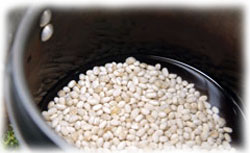 eat or whole chickens. Pressure
cookers are also available in a saucier-style pan in addition to
single or double-handled saucepan styles. A quality pot with a
heavy bottom and even heat distribution will prove versatile for
browning stages as well as reducing the chances of food sticking to
the bottom. Some pot systems feature steaming inserts, or
baking trays for stacking inside. A quality pressure cooker
will have thorough instructions and tips for its use. Acquaint
yourself with your pot's instructions, and you will be a pro in no
time! eat or whole chickens. Pressure
cookers are also available in a saucier-style pan in addition to
single or double-handled saucepan styles. A quality pot with a
heavy bottom and even heat distribution will prove versatile for
browning stages as well as reducing the chances of food sticking to
the bottom. Some pot systems feature steaming inserts, or
baking trays for stacking inside. A quality pressure cooker
will have thorough instructions and tips for its use. Acquaint
yourself with your pot's instructions, and you will be a pro in no
time!
|
Cooks'Wares'
Smart Bean Tips
|
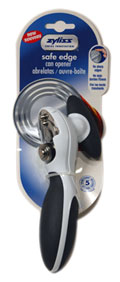 Tip #1: It's a great
strategy to keep a few cans of beans in your pantry for quick
access. Drain and rinse canned beans prior to adding them to
your dish. Choose a can opener that does not leave a sharp
edge or drop metal shavings into your food. OXO's Smooth Edge
and Zyliss' Safe Edge can openers are smart choices. Tip #1: It's a great
strategy to keep a few cans of beans in your pantry for quick
access. Drain and rinse canned beans prior to adding them to
your dish. Choose a can opener that does not leave a sharp
edge or drop metal shavings into your food. OXO's Smooth Edge
and Zyliss' Safe Edge can openers are smart choices.
Tip #2: Explore
unconventional ways to use beans! Add a 1/2 cup of cooked
beans to your morning smoothie mix; they will give a well-rounded
nutritional boost to your drink for just pennies. Add cooked
beans to your muffins, mashed or whole, for some amped up
nutrition.
Tip
#3: Mash cooked beans with a pastry cutter instead of a
potato masher; this helps to cut the outer skin surrounding the
bean. Mashed beans can be turned into a quick sandwich spread
with a few spices and herbs.
Tip #4: During very hot
weather, soak dried beans in the refrigerator. This will keep
the beans from fermenting and prevent a sour taste.
Tip #5: A one-pound package
of dry beans is the equivalent of about 2 cups dry, or about 4-5
cups cooked. A typical can of beans (15 oz.) will contain
about 1-1/2 cups of beans.
Tip #6: Try roasting cooked
beans in the oven and enjo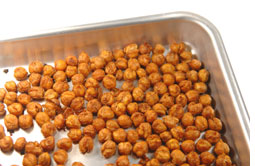 y the fact that roasted beans
have far less fat than most nuts. Pat dry two cups of cooked
beans, toss them with a tablespoon of olive oil, and sprinkle with
your choice of spices. Roast in a 350 F oven for an hour, or
until the beans are dry and crunchy. Grill rubs are perfect
spice mixes to use for roasting beans. y the fact that roasted beans
have far less fat than most nuts. Pat dry two cups of cooked
beans, toss them with a tablespoon of olive oil, and sprinkle with
your choice of spices. Roast in a 350 F oven for an hour, or
until the beans are dry and crunchy. Grill rubs are perfect
spice mixes to use for roasting beans.
Tip #7: Salt toughens the
outer skin of beans making them less permeable to water, and
lengthening the time it takes to cook. Add salt to beans only after
they are cooked to the desired
tenderness.
|
Q & A
|
 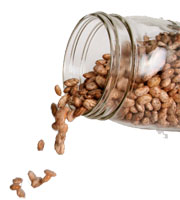 Q: I pressure cooked the beans as
directed, but they're not quite tender. What should I
do? Q: I pressure cooked the beans as
directed, but they're not quite tender. What should I
do?
A: Under-cooked beans
are no fun! Finish cooking the beans in the pressure cooker,
uncovered, on the stovetop, until the beans are soft all the way to
the center; it shouldn't take too long. Cooking times for
beans may vary according to variations in sizes, age of the bean,
and quantity of beans being cooked. As you gain experience
with pressure cooking beans you'll quickly become a pro in adjusting
cooking times to specific situations.
Q: I love beans, but they're hard on
my digestive system, if you get what I mean. . . .
A: It's true; beans can
affect some individuals in uncomfortable ways, but don't let that
keep you from eating beans. The culprits here are the complex
sugars found in beans. The undigested sugars produce a party
for local intestinal flora once they reach the large intestine, and
you know the rest of the story. Using the Hot Soak method noted
above can reduce the discomforting sugars by 50%. Also,
boiling beans at a full boil for 8-10 minutes before placing on
simmer will diminish the offending sugars. Alternatively, add
the missing enzyme, in pill or liquid form, prior to eating your
bean dish and you'll bypass the whole topic.
Q: I've cooked the beans more than
prescribed time, but they're still tough. What's
wrong?
A:
Tough beans can result from: (1) Cooking with salt. Salt
toughens the outer membrane of the bean making it less permeable to
water, and/or (2) Acidic ingredients may be present. Add
acidic ingredients, such as tomatoes, lemon juice, wine or vinegar,
only after the beans have cooked to tenderness. Other non-acidic
flavorings, such as onions, herbs, and garlic, may be added to the
beans from the beginning.
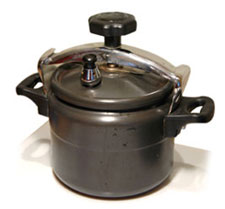 Q: Is pressure cooking
dangerous? Q: Is pressure cooking
dangerous?
A: In the olden days,
pressure cooking pans periodically "blew their lids off." But
stories of exploding pots are a thing of the past and part of
kitchen folklore. Today's pressure cookers have multiple
safety mechanisms that allow for very safe cooking and the
elimination of "user errors" that may have occurred more easily with
older pots.
Q: What is
the foam that sometimes appears when cooking beans?
A: A white-to-brown foam may
appear on top of a cooking pot of beans. It's not dirt. This foam
results from bean proteins coagulating on the water's surface.
Skim off the foam prior to using the beans. A teaspoon of oil
added at the start of cooking will prevent any scum or foam from
forming.
|
Cooks'Wares'
Cookbook Review
|
The Pressure
Cooker Gourmet, 225 Recipes for Great-Tasting, Long-Simmered Flavors
in Just Minutes by Victoria Wise. Copyright 2003.
Published by The Harvard Common Press, Boston
Massachusetts.
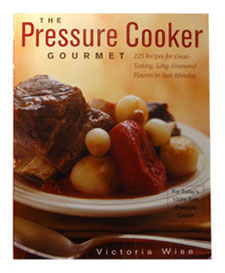 There couldn't be a more perfect resource
for discovering or rediscovering pressure cooking techniques.
The cookbook encompasses daily life in the kitchen with recipes for
breakfast, lunch, and dinner, and spans full menus of soups, salads,
entrées and desserts. Ms. Wise's elite culinary career brings
a great deal of panache and
contemporary taste to a subject that sometimes suffers from
stereotypes of the past. The pressure cooking instructions are
informational and in plain language. Ms. Wise concentrates on
creating flavor and delicious food with the pressure cooker as the
means for getting to a satisfying end. The book is organized
by food groups and, in her wording, recipes range from "homey to
haute." This book
gives every novice pressure cooker user the confidence to get
started, and supplies the experienced cook with plenty of sweet
successes that will keep the pressure pot busy every
day! There couldn't be a more perfect resource
for discovering or rediscovering pressure cooking techniques.
The cookbook encompasses daily life in the kitchen with recipes for
breakfast, lunch, and dinner, and spans full menus of soups, salads,
entrées and desserts. Ms. Wise's elite culinary career brings
a great deal of panache and
contemporary taste to a subject that sometimes suffers from
stereotypes of the past. The pressure cooking instructions are
informational and in plain language. Ms. Wise concentrates on
creating flavor and delicious food with the pressure cooker as the
means for getting to a satisfying end. The book is organized
by food groups and, in her wording, recipes range from "homey to
haute." This book
gives every novice pressure cooker user the confidence to get
started, and supplies the experienced cook with plenty of sweet
successes that will keep the pressure pot busy every
day!
|
Bean Recipes
|
Recipes excerpted from The Pressure
Cooker Gourmet, by Victoria Wise. (c) 2003, used by
permission from The Harvard Common Press. All rights
reserved.
Each of these recipes is suitable for
pressure-cooked beans, boiled beans, or even canned beans. We
hope you'll enjoy each of these recipes as much as we did, and vow
to incorporate more beans in your diet!
Lentil Salad
with Feta Cheese and Walnut Oil
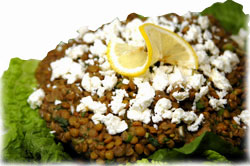 This lentil salad is so simple and easy
to make, we're determined to make it a frequent staple in our
refrigerator. It makes a perfect carry-to-work lunch that's
hearty, nutritious and satisfying. Among the legume family, lentils
are some of the most accessible. Because of their flat shape,
they cook up quickly and easily under pressure or in a saucepan
without pre-soaking. The combination of lentils and walnut oil
is divine; the nuttiness of each compliments the other. We
couldn't help but add a few freshly toasted walnuts on
top! This lentil salad is so simple and easy
to make, we're determined to make it a frequent staple in our
refrigerator. It makes a perfect carry-to-work lunch that's
hearty, nutritious and satisfying. Among the legume family, lentils
are some of the most accessible. Because of their flat shape,
they cook up quickly and easily under pressure or in a saucepan
without pre-soaking. The combination of lentils and walnut oil
is divine; the nuttiness of each compliments the other. We
couldn't help but add a few freshly toasted walnuts on
top!
Click here to view the
recipe.
Click here for a printable version of
the recipe.
Not-So-Classic
Red Beans and Rice
with Fresh
Thyme and Andouille Sausage
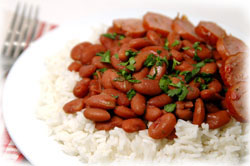 Just in time for Mardi Gras, (Tuesday, February
24, 2009), this variation on Red Beans & Rice will transport you
to New Orleans for at least one evening. Simple ingredients,
easily prepared, the saucy beans over rice are instant comfort
food. The andouille sausage's spicy, smoky sweetness lends
deep flavor to the beans as they meld together. Keep the
Tabasco sauce handy for a pass around the table. Laissez les
bons temps rouler! - Let the good times roll! Just in time for Mardi Gras, (Tuesday, February
24, 2009), this variation on Red Beans & Rice will transport you
to New Orleans for at least one evening. Simple ingredients,
easily prepared, the saucy beans over rice are instant comfort
food. The andouille sausage's spicy, smoky sweetness lends
deep flavor to the beans as they meld together. Keep the
Tabasco sauce handy for a pass around the table. Laissez les
bons temps rouler! - Let the good times roll!
Click here to view the
recipe.
Click here for a printable version of
the recipe.
White Beans
Bretonne
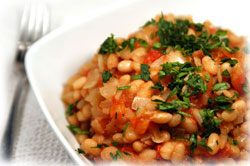 This dish exudes "simple elegance." The
onion, fresh tomato, and wine sauce gently cradle the white beans
and impart a delicate experience that you would never quite suspect
beans could have. If all you know of beans is chili or
refrieds, this preparation will clue you into the breadth and
versatility of beans as a simple gourmet food. Ms. Wise
explains in her introduction that this recipe was developed from her
days at the famous Chez Panisse restaurant where it was served with
lamb. Sounds like the beginning of a delectable spring
menu! This dish exudes "simple elegance." The
onion, fresh tomato, and wine sauce gently cradle the white beans
and impart a delicate experience that you would never quite suspect
beans could have. If all you know of beans is chili or
refrieds, this preparation will clue you into the breadth and
versatility of beans as a simple gourmet food. Ms. Wise
explains in her introduction that this recipe was developed from her
days at the famous Chez Panisse restaurant where it was served with
lamb. Sounds like the beginning of a delectable spring
menu!
Click here to view the
recipe.
Click here for a printable version of
the
recipe.
| |